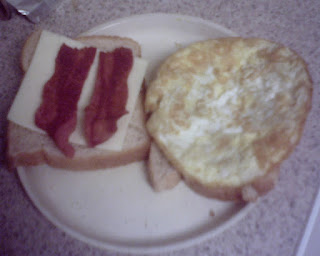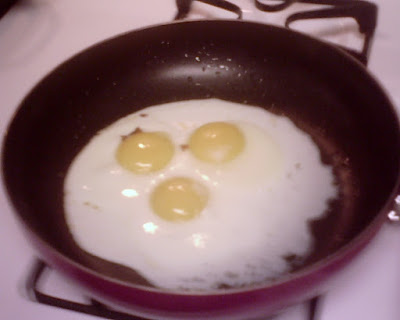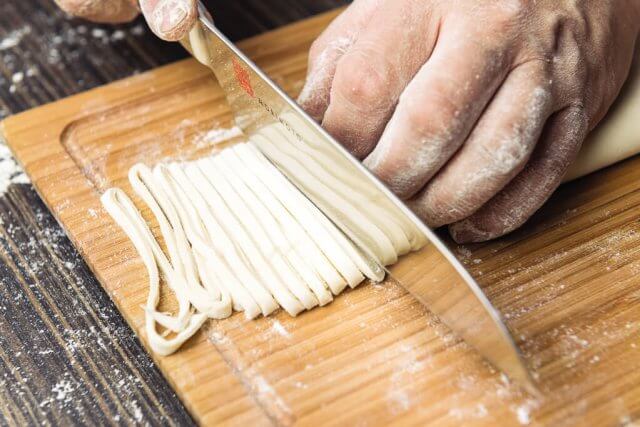In the beginning.
Tools plus live active yogurt.
Incubation time.
Done: (with applesauce)
What Do I Need to Make Yogurt?
All you need to make homemade yogurt is a half gallon of milk and about a
half cup of yogurt. Whole or 2% milk will make the thickest, creamiest
yogurt, but you can also use skim milk if you like. For the yogurt, either
Greek or regular yogurt is fine, but avoid any flavorings; stick to plain,
unflavored yogurts.
When you're buying yogurt, also check that it lists "Live Active Yogurt
Cultures" in the ingredients - we need those! The live cultures are what
actually turn the milk into yogurt. The number of cultures doesn't really
matter; as long as there is at least one, you can make yogurt. This said,
different strains of bacteria have different health benefits, so I
personally look for the yogurt with the most number of cultures lists.
Some common ones are L. Bulgaricus, S. Thermophilus, L. Acidophilus,
Bifidus, L. Casei.
What Equipment Do I Need?
All you need to make yogurt is a heavy pot with a lid. I like to use a
6-quart Dutch oven. Once the lid is on, a heavy pot like this does an
admirable job of keeping the milk cozy and at a fairly steady temperature
(ideally around 110DEGF) while the bacteria go to work turning the milk
into yogurt. It also helps to put the pot somewhere insulated and warm
while this is happening, like an oven with the light turned on or a picnic
cooler with a hot water bottle.
You can certainly use a yogurt maker or even a dehydrator if you have one
- these are great for holding the yogurt at a very steady temperature as
it incubates - but can make great yogurt without them.
What Next?
Once you have this basic method for making yogurt down pat, there are all
sorts of tweaks and changes you can make. Some people like to add dry milk
powder or gelatin for extra thickness, others like to strain off the
liquid whey for a dense Greek-style yogurt. Using different brands of
commercial yogurt to culture the milk can also give you subtly different
flavors and nutritional benefits.
How To Make Yogurt at Home
Makes about 2 quarts yogurt
What You Need
Ingredients
1/2 gallon milk - whole or 2% are best, but skim can also be used
1/2 cup commercial yogurt containing active cultures
Equipment
3 quart or larger Dutch oven or heavy saucepan with a lid
Spatula
Instant-read or candy thermometer (one that can clip to the side of the
pan)
Small measuring cup or small bowl
Whisk
Instructions
1. Heat the milk. Pour the milk into the Dutch oven and set over medium
to medium-high heat. Warm the milk to right below boiling, about
200 F. Stir the milk gently as it heats to make sure the bottom
doesn't scorch and the milk doesn't boil over. According to the
National Center for Home Food Preservation, this heating step is
necessary to change the protein structure in the milk so it sets as a
solid instead of separating.
2. Cool the milk. Let the milk cool until it is just warm to the touch,
112 F to 115 F. Stir occasionally to prevent a skin from forming.
(Though if one does form, you can either stir it back in or pull it
out for a snack!) You can help this step go faster by placing the
Dutch oven in an ice water bath and gently stirring the milk.
3. Thin the yogurt with milk. Scoop out about a cup of warm milk with a
measuring cup and add the yogurt. Whisk until smooth and the yogurt is
dissolved in the milk.
4. Whisk the thinned yogurt into the milk. Pour the thinned yogurt into
the warm milk while whisking gently. This inoculates the milk with the
yogurt culture.
5. Transfer the pot to the (turned-off) oven. Cover the Dutch oven with
the lid and place the whole pot in a turned-off oven - turn on the
oven light or wrap the pot in towels to keep the milk warm as it sets
(ideally around 110 F, though some variance is fine).
6. Wait for the yogurt to set. Let the yogurt set for at least 4 hours or
as long as overnight - the exact time will depend on the cultures
used, the temperature of the yogurt, and your yogurt preferences. The
longer yogurt sits, the thicker and more tart it becomes. If this is
your first time making yogurt, start checking it after 4 hours and
stop when it reaches a flavor and consistency you like. Avoid jostling
or stirring the yogurt until it has fully set.
7. Cool the yogurt. Once the yogurt has set to your liking, remove it
from the oven. If you see any watery whey on the surface of the
yogurt, you can either drain this off or whisk it back into the yogurt
before transferring to containers. Whisking also gives the yogurt a
more consistent creamy texture. Transfer the to storage containers,
cover, and refrigerate. Homemade yogurt will keep for about 2 weeks in
the refrigerator.
8. Your next batch of homemade yogurt. Once you start making your own
yogurt, you can use some of each batch to culture your next batch.
Just save 1/2 cup to use for this purpose. If after a few batches, you
notice some odd flavors in your yogurt or that it's not culturing
quite as quickly, that means that either some outside bacteria has
taken up residence in your yogurt or that this strain is becoming
weak. As long as this batch still tastes good to you, it will be safe
to eat, but go back to using some store-bought commercial yogurt in
your next batch.
Recipe Notes
o Cost Breakdown: We eat about a quart of yogurt a week in our house,
which was costing roughly $2.60 a week. A half gallon of milk makes a
little less than two quarts of yogurt, which has been just enough to last
us two weeks. We buy a local brand of milk that costs $3.70 per half
gallon ($1.85 per quart), so we end up saving about 75-cents per week on
yogurt. Nice.
o Holding the Temperature: If your milk drops below 110DEG while it's
incubating, that's fine. It will take a little longer to set and might end
up a little looser, but the bacteria in the yogurt culture will keep the
milk from spoiling. By the way, even after 8 hours in the oven
(overnight), our yogurt made in the Dutch oven still usually registers
about 100DEG when I take it out of the oven!
o Homemade Greek Yogurt: You can make Greek-style yogurt by straining
your homemade yogurt until it is as thick as you like. Read more about it
here: How to Make Thick & Creamy Greek-Style Yogurt










































